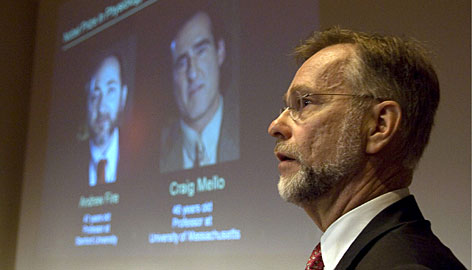By Liz Szabo and Dan Vergano, USA TODAY
American scientists Craig Mello of the University of Massachusetts Medical School and Andrew Fire of Stanford University School of Medicine won The Nobel Prize in physiology or medicine on Monday for their discoveries related to RNA interference, a process that researchers hope to use to silence disease-causing genes.
While effective therapies may be years away, RNA interference already can be used to learn the function of any gene in a cell, according to the Nobel Assembly at the Karolinska Institute in Stockholm, Sweden. The scientists didn't have to wait long for their work to be recognized. ON DEADLINE: Interview with the winners Mello, 45, and Fire, 47, published their pivotal paper on RNA interference in the journal Nature in 1998. Their groundbreaking work "opened a new window on the cell" and launched a new field of science, says Jeremy Berg, director of the National Institute of General Medical Sciences, part of the National Institutes of Health, which helped fund the research. At a press conference, Fire, who conducted his research while at the Carnegie Institution in Washington, said the study of RNA interference, or RNAi, has "just exploded" in recent years. Their research has been patented, according to the Carnegie Institution, and has been licensed in the USA, Europe and Japan. Ribonucleic acid, or RNA, normally occurs as a single strand of genetic material. It acts as a go-between inside cells. It is best known for using the instructions provided by DNA as a template to construct proteins, which perform any number of jobs inside the body: digesting food, sending signals inside the brain, fighting off bacteria. Certain viruses have two-stranded RNA. Some scientists believe cells may have evolved the RNA interference system to defend themselves against infection by these viruses, according to the Nobel Assembly. Cells that detect double-stranded RNA activate a system to keep suspect genes turned off. Doctors are already using RNAi to try to treat macular degeneration, a form of blindness, in preliminary trials in people, Berg says. Researchers also have successfully used RNAi to silence a gene that causes high blood cholesterol in animals, according to the Nobel Assembly. Scientists hope to develop silencing RNA to treat viral infections, heart disease, cancer and other diseases. Before RNAi can be used to cure people, though, researchers need to find a way to get the molecules to the right places in the cell, says molecular biologist Miles Wilkinson of the University of Texas M. D. Anderson Cancer Center. In terms of treating disease, "it is a little early, but there is huge potential," for RNAi, Wilkinson says. "Their work has been extremely important and the award is certainly appropriate." For biologists, Wilkinson says, RNAi and related techniques shave years off studies to determine the function of genes. Where it might take three years to breed "knock-out" mice that lack a certain gene, RNAi allows a similar study of gene function in mice in perhaps six months. And RNAi allows researchers to gauge the effects of turning down a gene's activity after the mouse reaches adulthood, something that is difficult to achieve with knock-out mice, which are generally born lacking a gene, Wilkinson says. RNAi can be adjusted to limit gene activity in different doses. "It has been tremendously useful," he says. At a separate press conference, Mello said the news "hasn't really sunk in yet." He noted that many others have contributed to the understanding of RNAi, adding that he feels "indebted to so many people." Mello says he became fascinated by science as a child because of his father, a paleontologist, which he described as "a dream job for any 5-year-old." Mello says he enjoys the challenge of science. "The fun thing about science is that you are almost always wrong," he says. "It's fun to be wrong because when you are wrong, you learn something." Mello says he hopes the prize will encourage greater funding of basic scientific research. "We're losing time now because we're not spending enough money," Mello says. "I want to get right back to work."
|
||||||||||||||||||||||||||||||||||||||||||||||||||||||||||||||||||||||||||||||||





